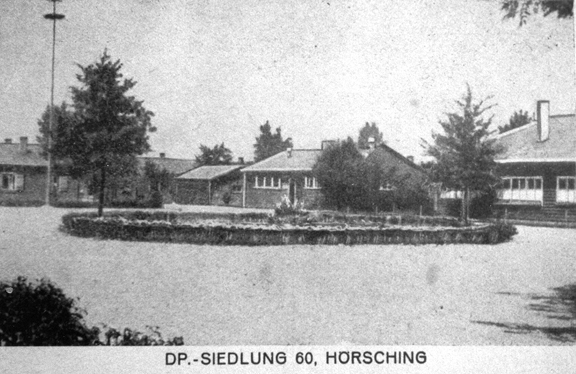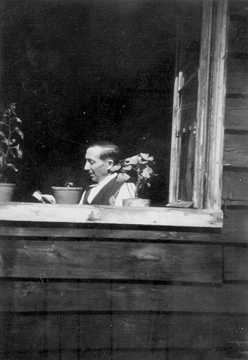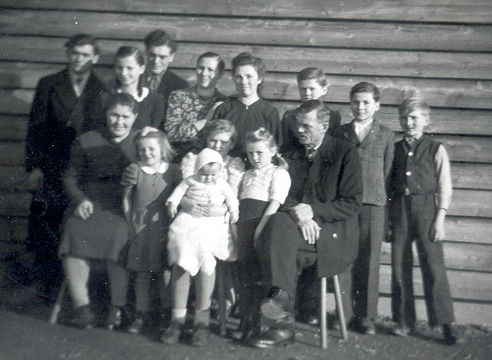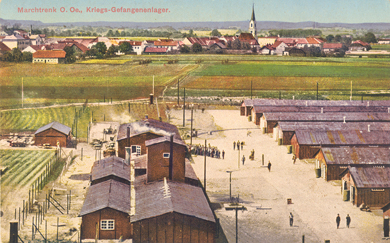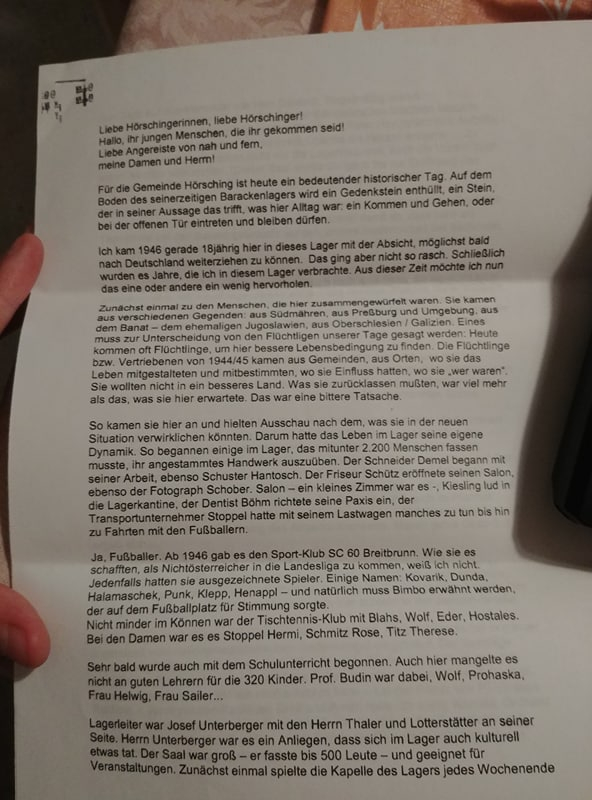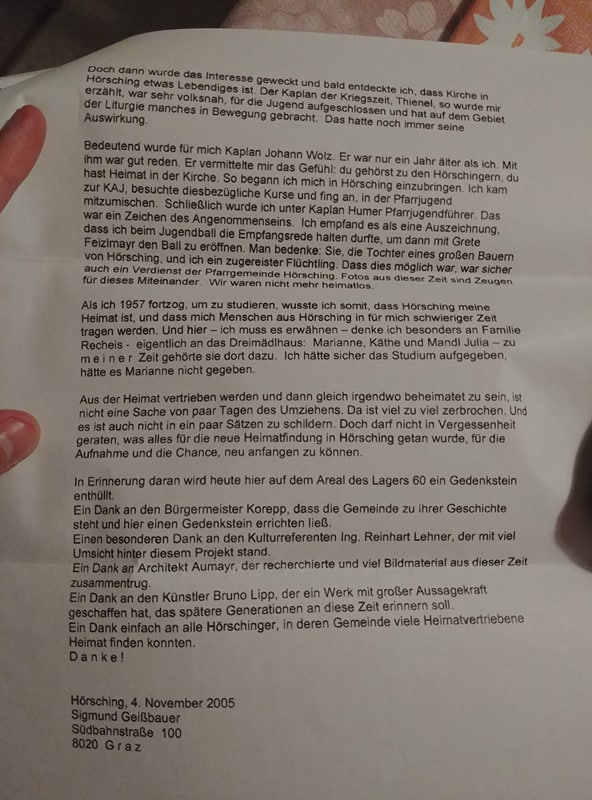Displaced Persons of D P. Siedlung 60 Hoersching / Hörsching DP Camp in Austria
Hörsching DP Camp 60, See Kirchenholz; US zone
Archives: Landesarchiv Oberösterreich“ (= the archive of the federal state Upper Austria)
Sabine Sammer
Magistrat der Landeshauptstadt Linz
Personal und Zentrale Services, Archiv der Stadt Linz
4041 Linz, Hauptstraße 1-5
Tel. +43 / 0732 / 7070-2981
Fax +43 / 0732 / 7070-2962
Email to: Sabine.Sammer@mag.linz.at
visit http://www.linz.at/archiv
In the Hoersching Buried Excel file is
data on the victims buried in Kirchenholz, a small wood by Hörsching.
In 1948 the Austrian Schwarzes Kreuz (an organization that looks after the
graves of war victims) opened these graves and transferred the dead to the
St. Martin cemetry (Linz) for reburial. For further information contact:
GR Selam Ebead
Kaiserweg 3
4063 Hörsching
hoersching@gruene.at
http://www.hoersching.gruene.at
Firma:
T: +43 (0) 7243 / 519 73
F: +43 (0) 7243 / 519 77
I: +43 (0) 7243 / 519 74
http://www.wak.at
ebead@wak.at
July 3, 2007 Dear Olga Kaczmar!
Is a very
good homepage about DP camps in Austria. I'm sending you pictures
and the history in German from Lager 60 in Hoersching (near Linz)
in Upper Austria. There were 18 houses and kitchen house - look
at the plan (to the right). The last two houses were demolished in year 1998.
I've been
living in Hoerschig since 1987 on my grandmother's farmhouse.
It´s near the camp and so I´m very interested in the history.
I was born in Linz in Upper
Austria and I know stories only from local word of mouth.
Since I got the property from my family here in Hoersching, I´m
looking for information and photos of this time period.
With kind regards
from Upper Austria,
Hans Aumayr, arch.aumayr@gmail.com
Architekt
Dipl.-Ing. HANS AUMAYR
The History of Camp 60 in Hoersching
Author Hans Aumayr, 2005-11-03 arch.aumayr@gmail.com
(computer translation)
The history of camp 60 in Hoersching 1. labour camps - established 60
years ago.
• Before 1938, Hoersching
was a small farm village.
• In 1938, the camp
was established by the German armed forces for the building of
the air base.
• Groundbreaking
celebration by Field Marshal Hermann Goering was on 13 May 1938
(at the same time with groundbreaking celebration of the Hermann
Goering of works - late Voest)
• From 1939 mostly
foreign slave laborers (and also prisoners of war) were used for
the building of the air base and were accommodated in the barracks
camp. Ten thousands workers passed through this camp.
• To 1940/41 came
captured Frenchmen.
• In Spring 1941
came about 800 captured Polish.
• In the late Summer
1941 came Russian prisoners of war.
• With the end of
war, Hoersching was flooded with former prisoners from the camp Gunskirchen, POWs (mainly Hungarian
Jews) were released by Americans, and in the course of the years,
they filled the abandoned labour camp.
• With the outbreak
of typhus fever, an emergency military hospital were furnished.
The municipality physician, Dr. Hans Recheis, and many of his aids
came down with typhus. (The doctor's daughter, Hoerschinger author
Kaethe Recheis (born on 11 March 1928) - wrote about it also in
book "Das Schattennetz" (The
Shade Net) and/or described this time period in the book, "Lena
- unser Dorf und der Krieg“ (Lena - Our Village and the
War"). Dr. Recheis died of typhus on 9 June 1945. Camp
60 was a transit station for thousands of refugees.
• After all of the former prisoners were taken out of the camp, Hoersching
became a transit camp for refugees from the east and southeast. They lost their homeland due to the war and the collapse of the
German Reich. They predominantly originated from Südmähren, Pressburg and Yugoslavia (mostly from the Batschka, Gross Betschkerek,
Rudolfsgrad, Esseg, Djakovo, Vinkovce und Vukovar).
• The 18 barracks
became extremely full (approx.. 2200 persons were it).
• A school for the
children with own teachers in the Kuechentrakt was established
for the newly arrived.
• From August to November 1945, provisionally a second lieutenant
of the Amis held the command of the camp, that afterwards of the
office the oö. Federal state government was taken over. The
camp was now called D P Siedlung 60, Hoersching
(which meant: D P = displaced person, housing development 60 in Hoersching).
• Ten thousands in
Wohnsiedlung 60 of the accommodated continued to migrate to the
Federal Republic of Germany, also to USA and to Canada. Many remained
in Hoersching and pulled into a dwelling and/or established a house.
Some still today live in Hoersching.
• In the camp was
also a meeting room for approx. 500 persons, which found up to
the opening of the people home on 9 February 1964 used for group
dance and meetings. Also cultural life was introduced. In the camp
among other things performed the Exlbuehne, the Viennese singer
boy, Peter Hey with Maxi Boehm, Leopold Schmiedseder, Maria von
Schmedes, the Magier Rayo as well as a farmer theatre for guest performance.
• The camp produced a very successful soccer association. By
Autumn 1945 a camp crew was educated. A connection at the Hoerschinger
sports club failed, so that its own association with the name sport
club 60 Breitbrunn was created. It organized a section table tennis
also. To sporty successes (in 1948/49 ascended into the Austrian. national
league) were due on the part of the Austrian football federation
efforts under way to weaken the "foreigner associations" union
sports club Breitbrunn and HAKOAH Linz by limited use from not Austrian
citizens to (Nichtoesterreicherstatus of. 17. June 1948).
• In August 1952 a memorial plaque with the inscription was
installed in the green island of the camp yard: "Established
to the memory of the dead refugees from homelands in all world",
which with the establishment of the Lawog housing estate was probably
destroyed. 1. The last 2 barracks are rented as dwellings.
• In the last years,
the two still existing warehouse were rented out for private use
and as dwellings.
• In Autumn 1997
the market municipality bought the last barracks in Hoersching.
• In the February
1998, 60 years after the establishment becomes this cultural monument
that closely connected with the history of Hoerschings, was torn down.
• On
4. 11. 2005 stone monument was erected at the former location to
the memory of the camp inhabitants and/or refugee of homeland.
I came across your website http://www.dpcamps.org/Hoersching.html while researching information about my grandfather's past. My grandfather, Sigmund Gaisbauer, grew up in the Hoersching DP Camp from 1946-1952. He also appears in this photo on the website at the far right with his sister, Anastasia Mueller, to the left of the man on the stool. Tommy Jones tommy.jones56@yahoo.com
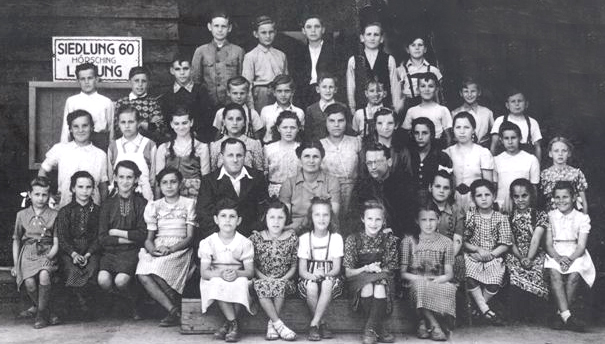
Older students, Siedlung Camp 60
Sigmund Gaisbauer top row 2nd from the right. Tommy Jones
March 23, 2015 Lady Olga Kaczmar!
I have these 2 pictures above taken yesterday at an exhibition in Linz Castle from a panel about the camps in Upper Austria.
Yours sincerely Hans Aumayr arch.aumayr@gmail.com
DP camps 53, 55, 58, 65, 73, 76, 77
Camp life written below submitted by Tommy Jones tommy.jones56@yahoo.com
I also have this information that you may find useful for the website written by his cousin, Sigmund Geissbauer (not Gaisbauer) about what life was like in the camp.
I hope you find it beneficial to the website. Professor Budin is mentioned in the documents and my grandfather spoke very highly of him very frequently.
If there is anything you would like more clarification or more information on, I can ask my grandmother what my grandfather told her but unfortunately he passed in 2015 in a hospice facility in Milford, Delaware, USA. Tommy Jones tommy.jones56@yahoo.com
From: Al Fleischer
Thursday, November 28, 2019
Subject: Re: Horsching Camp
I was born in Linz and lived in that camp till the age of 6.
My mother grew up in Mozovic, Yugoslavia. The war forced her as a 18 year old girl to flee with her family to the safety of Austria. My father was born in Brasov, Romania and as a German soldier ended up running a community farm near Horsching. I recall hearing my dad talk about French and other prisoners who after the war stayed on that farm until they reconnected with people in their homeland.
The first two photos are of such people with my father being the man not wearing a cap. My mother was placed on my dad's farm and once the DP camp was constructed, they married and moved in. I was born in 1950 and the next two photos are of me in the camp Kindergarten. Sorry I do not know the teacher's name.
My father quickly learned to speak English and working with the US Air-Force became a fireman (Next two Photos). From what I understand both the military and civilian fire departments were located on the air base. They would both cooperate in responding to fires. From what I recall my dad eventually became the civilian fire chief. He was stationed at the fire house two full days on the two days off. This job paid a bit better than the average wages at that time which allowed my parents to purchase a few luxury items that other people could not. Dad was able to purchase a motorcycle with a side car which afforded mom and dad the opportunity to travel while I was in the camp with grandmother.
Dad having worked with the local farmers and knowing them would sometimes obtain their local hard cider (Most) or Schnapps and trade that for American cigarettes from the GIs at the base. He would then use the cigarettes as barter currency in order to obtain things only available on the black market.
My mother eventually worked at the airbase as either a housekeeper/ cleaning lady for the officers' wives or doing laundry for the enlisted men. I was occasionally taken to visit dad on the base. All the GIs were nice to me for they all knew my dad. I soon learned to say " GI have some gum? " The soldiers would often then toss me a packet of gum. It was generally the two pack of Chiclets. I recall that as kids chewing gum like the Americans made you feel like a big shot. A few times when I or my friends did not have gum we would pull tar that was freshly applied to parts of the camp buildings and chew that. I am sure that was not good for us but it had a bitter sweet taste and the texture allowed you to chew it for some time.
The next photo is of me and a Santa. It was taken when I was about four. Growing up I knew about St Nicholas and Das Christkind but a Santa Claus was something strange to me. The Base has someone dress up and distribute presents to the kids of the camp. I recall my confusion as I tried to understand why this was all happening. I received a large wrapped package but when my mother unwrapped it it had a wonderful toy but also a girl's dress. Much to my dismay mom told me that we needed to exchange the entire package for a boy's present. The new package had a shirt and pants and just a small plastic car. Needless to say I was disappointed in this event.
The next photo is of mom and dad celebrating at the recreation hall. I do not know exactly where in the camp it was but mom in later years reminisced how wonderful those times were. They did not have anything fancy to eat or drink but being with relatives and people who also lost their homes due to the war made lasting friendships.
The next picture is of my family slaughtering a pig. It was an annual event in the late fall. The meat was smoked and provided meat through the winter. There is a story about butchering pigs that helped mom and dad decide to come to America. It would take the combined money my parents earned for over a month to buy a pig.
My mother's sister immigrated to Canada in 1956. She soon wrote back to us that it would only take her less than a week's wages to buy a pig if she wanted to. My dad later told me that with that comment and knowing how reckless Americans were about handling and saving money we would do well in America.
Due to dad's involvement at the airbase we were allowed to immigrate to Cleveland Ohio once the base was closed in 1956. The last two pictures are of Christmas in our rooms at the camp. You will notice in the one photo a radio on the wall. Dad was able to obtain it early after the war and there were many nights when the neighbors would come over to our room to listen to the news or some music.
I recall about a year before we left for America the number of people in our building decreased. I think we originally had one room to live in. Once the room next to ours became empty I remember dad cutting a door into that room so that we had a separate kitchen and bedroom.
Well, this is all I can offer about the Horschinger Lager, and I'm looking forward to hearing from others.
Albert Fleischer
DRALF@HOTMAIL.COM
The first two photos are of such people with my father being the man not wearing a cap.
All the GIs were nice to me for they all knew my dad. I soon learned to say " GI have some gum? " The soldiers would often then toss me a packet of gum. It was generally the two pack of Chiclets.
Al Fleischer dralf@hotmail.com





